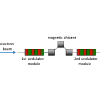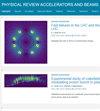Experimental characterization of the optical klystron effect to measure the intrinsic energy spread of high-brightness electron beams
IF 1.8
3区 物理与天体物理
Q3 PHYSICS, NUCLEAR
Physical Review Accelerators and Beams
Pub Date : 2024-03-01
DOI:10.1103/physrevaccelbeams.27.030701
引用次数: 0
Abstract
The intrinsic energy spread of electron beams needs to be measured to characterize and optimize high-brightness electron beam sources such as those driving x-ray free-electron lasers (FELs). We demonstrate the use of the optical klystron effect as a precise and high-resolution method to measure the electron beam energy spread. The optical klystron setup consists of undulator modules and magnetic chicanes placed between them. The energy spread is found by measuring the radiation power produced in the undulators as a function of the chicanes’ strengths. High resolution and simplicity are the advantages of this approach, in contrast to the standard method, which measures the longitudinal phase space of the electron beam with a transverse deflector. The demonstration was performed at Athos, the soft x-ray FEL beamline of SwissFEL, for which we measured energy spreads below 1 MeV at a central beam energy of 3.4 GeV. We have verified the consistency of the method for different parameters (radiation wavelengths, undulator polarization configurations, and electron bunch durations) and we have benchmarked it against the standard measurement approach using a transverse deflector. Our results confirm the optical klystron as a valid approach to measure the electron beam energy spread. The method can be especially useful to reconstruct low energy spread values, where the conventional approach may be resolution limited, such as in ultra high-brightness radiofrequency photoinjectors or plasma sources, or when transverse deflectors are not available.

测量高亮度电子束本征能量扩散的光学喀斯特效应的实验表征
需要测量电子束的内在能量分布,以确定高亮度电子束源(如驱动X射线自由电子激光器(FEL)的电子束源)的特性并对其进行优化。我们展示了如何利用光速斯特龙效应来精确、高分辨率地测量电子束能量扩散。光学卡氏管装置由起伏模块和放置在它们之间的磁性卡氏管组成。能量扩散是通过测量起伏器中产生的辐射功率与磁卡槽强度的函数关系来实现的。与使用横向偏转器测量电子束纵向相位空间的标准方法相比,这种方法具有分辨率高和操作简单的优点。演示是在 SwissFEL 的软 X 射线 FEL 光束线 Athos 上进行的,我们测量了中心束能量为 3.4 GeV 时低于 1 MeV 的能散。我们验证了该方法在不同参数(辐射波长、减压器偏振配置和电子束持续时间)下的一致性,并将其与使用横向偏转器的标准测量方法进行了比较。我们的结果证实了光学速调管是测量电子束能量扩散的有效方法。这种方法对于重建低能量扩散值特别有用,因为传统方法的分辨率可能会受到限制,例如在超高亮度射频光射器或等离子体源中,或者在没有横向偏转器的情况下。
本文章由计算机程序翻译,如有差异,请以英文原文为准。
求助全文
约1分钟内获得全文
求助全文
来源期刊

Physical Review Accelerators and Beams
Physics and Astronomy-Surfaces and Interfaces
CiteScore
3.90
自引率
23.50%
发文量
158
审稿时长
23 weeks
期刊介绍:
Physical Review Special Topics - Accelerators and Beams (PRST-AB) is a peer-reviewed, purely electronic journal, distributed without charge to readers and funded by sponsors from national and international laboratories and other partners. The articles are published by the American Physical Society under the terms of the Creative Commons Attribution 3.0 License.
It covers the full range of accelerator science and technology; subsystem and component technologies; beam dynamics; accelerator applications; and design, operation, and improvement of accelerators used in science and industry. This includes accelerators for high-energy and nuclear physics, synchrotron-radiation production, spallation neutron sources, medical therapy, and intense-beam applications.
 求助内容:
求助内容: 应助结果提醒方式:
应助结果提醒方式:


